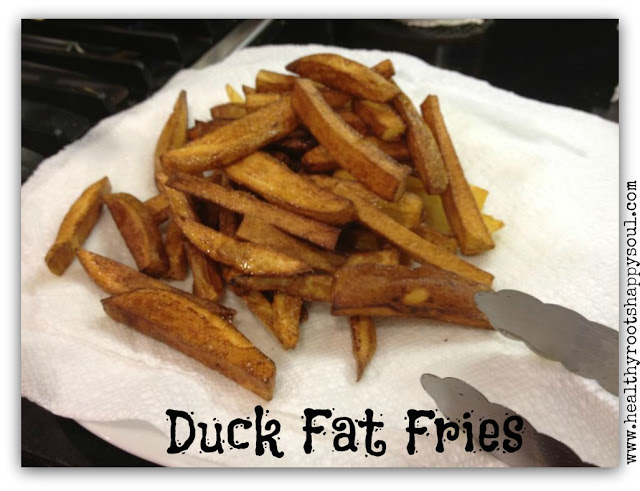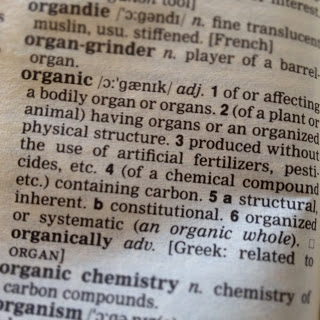Last night I was feeling a little lazy so I decided to whip up some homemade BBQ sauce and throw it on a bunch of chicken wings we got from our farmer’s market. And what to go with the wings? Well, nothing goes better with chicken wings than a side of french fries.
How to cook the fries was the question. I know I didn’t want to go buy a bag of frozen fries (yuck) and I’ve tried baking cut up, fry-sized potatoes (they didn’t turn out very well). The only option left was to fry them. But what to fry them in?
The last thing you want to do is eat potatoes that were fried in vegetable oil. When potatoes are fried in things like vegetable oil, canola oil or even olive oil they tend to lean heavily on the unhealthy side. Even more unfortunate, pretty much all restaurants and fast food chains fry their french fries in some type of vegetable oil.
All vegetable oils are highly industrially processed, rancid, denatured oils and contain polyunsaturated Omega-6 fatty acids. These fatty acids are very unstable therefore very unsafe to use at high temperatures.
Side note: Olive oil is a very fragile oil so is not recommended to be used for high heat cooking. When used at high heat, the oil will oxidize and potentially release free radicals. Olive oil is best when made in homemade dressings or a light saute.
 |
| our yummy wings |
When you fry something you want to use a healthy, stable fat that will not oxidize. Stable fats would include tallow, lard, coconut oil, and duck fat. Some people may argue that using peanut oil is safe but because they contain very high amounts of Omega-6 fatty acids, it’s wise to only use peanut oil sparingly.
Starchy foods (i.e., potato chips, french fries) that are heated or processed at a high temperature can release a carcinogen called acrylamide. Note: Even if the chips are baked, the potato is still exposed to very high heats which releases the carcinogen. Please keep in mind that acrylamide can still be formed when frying in healthy oils like tallow, duck fat, lard and coconut oil.
This is why frying your own french fries is the best way because you can control the heat (generally want a medium to low heat) so you minimize your chance of overheating the potatoes. You can also control the quality of ingredients you use like having organic potatoes and high quality sea salt. Potatoes are grown in the ground therefore more exposed to all kinds of chemicals that may be present in the soil. Organic potatoes are highly recommended over conventional and the organic ones are known to have a way better flavor.
Unfortunately tallow can not be found in a supermarket but can be found from a local farmer. If you don’t have a local farmer you may need to find a trustworthy source online and mail-order it.
I decided to use duck fat because I read on numerous websites they made excellent fries and that duck fat is highly prized in Europe for frying potatoes. I actually ended up finding the duck fat at my local Whole Foods, believe it or not! I researched the farm it came from and although there were a few things I was finicky about, I knew it was the best alternative to vegetable oils. It also resulted in some delicious tasting fries.
I do want to state that fats like tallow, lard and duck fat are more expensive then your general bottle of vegetable oil. This one of the biggest reasons why so many restaurant and fast food chains use this oil to cook with. The benefits of the healthy fats outweigh the few extra dollars you may spend when buying them instead of the few dollars you may save when buying unhealthy vegetable oils. So don’t be sticker shocked when you see the price of quality tallow, lard or duck fat!
Duck fat fries
Ingredients: (serves 2-3 people)
- 2-4 organic yukon gold potatoes
- sea salt
- duck fat or tallow
Directions:
- Cut potatoes into favored thickness
- Grab a small sauce pan and add some duck fat to it (duck fat and tallow are solid at room temperature so you’ll just want to take a spoon and dig out a chunk of fat)
- Turn the stove on medium heat and let the fat melt. You want enough to cover the height of the potato
- Add small amount of potatoes (enough to fill the bottom of the pan but not too much to crowd the potatoes)
- The potatoes will sizzle and you’ll want to let them sit for 5-7 minutes or until golden brown
- Take the golden fries out of the pan and set them on a dish. While hot, add sea salt
- Repeat steps until you’re done with all the potatoes
Voila! Delicious, sinless french fries.
Until next time,
Loriel – Healthy Roots, Happy Soul







